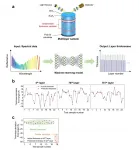(Press-News.org) BUFFALO, N.Y. -- In the dark waters of Lake Superior, a fish species adapted to regain a genetic trait that may have helped its ancient ancestors see in the ocean, a study finds.
The research focuses on kiyis, which inhabit Lake Superior at depths of about 80 to over 200 meters deep. These fish, known to scientists as "Coregonus kiyi," belong to a group of closely related salmonids known as ciscoes.
In contrast to three other Lake Superior ciscoes that dwell and feed in shallower regions of water, the kiyis are far more likely to carry a version of the rhodopsin gene that probably improves vision in dim "blue-shifted" waters, the study concludes. Every one of 21 kiyis the team examined from this deep-water population carried only this variant of the gene.
The adaptation appears to mark a return to an ancient state: Some 175 million years ago, the kiyis' ocean-dwelling forebears likely harbored the same genetic variant, according to a reconstruction of the species' evolutionary history.
Then, as ancestral fish populations moved from blue-shifted marine waters into shallower, "red-shifted" streams and lakes, a form of rhodopsin that's beneficial in those habitats became more common, scientists say. Finally, the kiyis, reaching the deep waters of Lake Superior, adapted again to the "blue-shifted" color of the waters they now inhabit.
The study was published online Nov. 28 in the journal Genome Biology and Evolution. The project, funded by the Great Lakes Fishery Commission, was a collaboration among researchers at the University at Buffalo and the U.S. Geological Survey's Great Lakes Science Center.
"Evolution is often thought of as a one-way process, at least over deep time, but in this example, over 175 million years, we have this reversal back to a much earlier ancestral state," says Trevor Krabbenhoft, PhD, assistant professor of biological sciences in the UB College of Arts and Sciences and a faculty member in the UB RENEW Institute. Krabbenhoft led the research with first author Katherine Eaton.
"Fishery biologists are trying to restore native fish populations in the Great Lakes, so it's important to understand the adaptations that species have," says Eaton, a PhD student at Auburn University who completed the study at UB as an undergraduate in biological sciences. "Knowledge of a species' adaptations can help us restore them in environments that are better suited to their biology."
Restoring fish in the Great Lakes
It's unclear whether the kiyis' ancestors completely lost the blue-shifted gene variant before re-evolving it, or if the variant simply became less frequent in this fish lineage before re-emerging to become more prolific again.
Either way, today, "There is a really clear distinction between the deep-water and shallow-water species," Eaton says.
Whereas all of the kiyis studied had the blue-shifted form of rhodopsin, the shallower water ciscoes sampled -- Coregonus artedi, Coregonus hoyi and Coregonus zenithicus -- primarily had the version of the gene that may be helpful in red-shifted waters.
Eaton notes that the same blue-shifted variant of rhodopsin is present in a number of other fish that live in the sea or deep lake water. This repeated "parallel" evolution can indicate that an adaptation has an important function: in this case, probably helping fish see in different environments, she says.
These insights are important because light in the Great Lakes is changing, Krabbenhoft says. For example, invasive zebra and quagga mussels, which filter organic matter from lakes, are increasing the clarity of the water in places.
The knowledge is also valuable as scientists look to restore native fish populations. In addition to the rhodopsin research, Krabbenhoft is a co-author of a study examining the genetics, morphology and ecology of ciscoes more broadly. That work, also funded by the Great Lakes Fishery Commission, was led by Moisés Bernal, PhD, now an assistant professor of biological sciences at Auburn University. The study results were posted on Dec. 16 to the preprint server bioRxiv, and have not yet been published in a peer-reviewed journal.
"Collectively, these projects have implications for restoring the native biodiversity in the Great Lakes toward a healthy ecosystem," Krabbenhoft says. "Ciscoes were once much more abundant and diverse across the five Great Lakes, but some species went extinct due to overfishing, sea lamprey invasion and pollution. Our data are informing restoration strategies as these fish are being re-established in places where they were lost or highly reduced in number, such as in Lake Ontario."
"Ciscoes were once the dominant native prey species in the Great Lakes, supporting top predators such as lake trout and walleye. They remain an important component of the tribal, commercial and recreational fisheries, which are valued at more than $7 billion annually," says Bill Taylor, PhD, Commissioner for the Great Lakes Fishery Commission and a University Distinguished Professor in Global Fisheries Systems at Michigan State University. "Research to better understand their biology and morphology is critical to designing successful restoration efforts in the future."
INFORMATION:
Authors of the rhodopsin paper are Krabbenhoft; Eaton; Bernal, who completed the work as a UB postdoctoral researcher in biological sciences; Nathan Backenstose, a UB PhD student in biological sciences; and Daniel Yule, a research fisheries biologist at the Lake Superior Biological Station, part of the U.S. Geological Survey Great Lakes Science Center. Eaton's research was supported by the Philip G. Miles Undergraduate Research Fellowships in the UB Department of Biological Sciences, and the UB Honors College.
Curtin University researchers have uncovered a method of making silicon, found commonly in electronics such as phones, cameras and computers, at room temperature.
The new technique works by replacing extreme heat with electrical currents to produce the same chemical reaction that turns silica into silicon at a reduced economic and environmental cost.
Lead researcher, PhD candidate Song Zhang from Curtin's School of Molecular and Life Sciences said that while the team's discovery was made at the nanoscale, it defines a way of replacing thermochemical processes with electrochemical processes, which ...
With the recent explosive demand for data storage, ranging from data centers to various smart and connected devices, the need for higher-capacity and more compact memory devices is constantly increasing. As a result, semiconductor devices are now moving from 2D to 3D. The 3D-NAND flash memory is the most commercially successful 3D semiconductor device today, and its demand for supporting our data-driven world is now growing exponentially.
The scaling law for 3D devices is achieved by stacking more and more semiconductor layers, well above 100 layers, in a more reliable way. As each layer thickness corresponds to the effective channel length, accurate characterization and control of layer-by-layer thickness is critical. To date, ...
Giant ambush-predator worms, possible ancestors of the 'bobbit worm', may have colonized the seafloor of the Eurasian continent around 20 million years ago. The findings, based on the reconstruction of large, L-shaped burrows from layers of seafloor dating back to the Miocene (23 million to 5.3 million years ago) of northeast Taiwan, are reported in Scientific Reports this week.
Ludvig Löwemark and colleagues reconstructed a new trace fossil, which they name Pennichnus formosae, using 319 specimens preserved within layers of seafloor formed during the Miocene era across northeast Taiwan. Trace fossils are geological features such as burrows, track marks and plant root cavities preserved ...
BOSTON - Four years after patients with melanoma were treated with a personalized cancer vaccine, the immune response kindled by the vaccine remains robust and effective in keeping cancer cells under control, researchers at Dana-Farber Cancer Institute, Brigham and Women's Hospital, and the Broad Institute of MIT and Harvard report in a new study.
The findings, published online today by the journal Nature Medicine, demonstrate the staying power of the immune response generated by the vaccine, known as NeoVax, which works by targeting specific proteins on each patient's tumor cells. The researchers found that, nearly four ...
While it has been reported that opioid overdose deaths have increased during the COVID-19 pandemic, a new study looking at data in Philadelphia showed that this hardship has been overwhelmingly suffered by Black individuals. Researchers from the Perelman School of Medicine at the University of Pennsylvania analyzed the period of time after the city's stay-at-home order was announced in 2020 and showed that, compared to the year before, the number of fatal overdoses suffered by Black individuals spiked by more than 50 percent. At the same time, the rate for white individuals actually fell by 31 percent over the same period. This research ...
PORTLAND, OR - A first-of-its-kind randomized clinical trial found that patients with pancreatic cancer didn't live any longer than expected after receiving pre-operative chemotherapy from either of the two standard regimens, according to trial results published in JAMA Oncology.
While the trial findings did not show a direct patient benefit, they do show that it's possible to safely administer chemotherapy prior to pancreatic cancer surgery. They also pave the way for better treatment testing for this notorious killer. With no symptoms in the early stages, and few effective therapies, pancreatic cancer is the fourth-most deadly cancer type in the United ...
What The Study Did: This study monitored suicide-related internet search rates during the early stages of the COVID-19 pandemic in the United States and researchers report searches for suicide decreased during that time. Although this study cannot independently confirm that changes in search rates were caused by changes in population-level suicide rates, it showed that COVID-19 may have been inversely associated with population suicide trends between March and July 2020.
Authors: John W. Ayers, Ph.D., M.A., of theUniversity of California San Diego, is the corresponding author.
To access the embargoed study: Visit our For The Media website at this link https://media.jamanetwork.com/
(doi:10.1001/jamanetworkopen.2020.34261)
Editor's ...
What The Study Did: Evidence of SARS-CoV-2 RNA in human corneas was examined in this study.
Authors: Maria Casagrande, M.D., of the University Medical Center Hamburg-Eppendorf in Hamburg, Germany, is the corresponding author.
To access the embargoed study: Visit our For The Media website at this link https://media.jamanetwork.com/
(doi:10.1001/jamaophthalmol.2020.6339)
Editor's Note: The article includes conflict of interest and funding/support disclosures. Please see the article for additional information, including other authors, author contributions and affiliations, conflict of interest and financial disclosures, and funding and support.
INFORMATION:
Media advisory: The full article is linked to this news release.
Embed ...
What The Study Did: Researchers assembled suicide death data for people 10 and older from January 2015 through May 2020 in this observational study and they report stable rates of suicide deaths during the COVID-19 stay-at-home advisory in Massachusetts, a finding that paralleles others following ecological disasters.
Authors: Jeremy Samuel Faust, M.D., M.S., of Brigham and Women's Hospital and Harvard Medical School in Boston, is the corresponding author.
To access the embargoed study: Visit our For The Media website at this link https://media.jamanetwork.com/
(doi:10.1001/jamanetworkopen.2020.34273)
Editor's ...
What The Study Did: This study estimated the frequency of reported forgone medical care because of the COVID-19 pandemic from March to mid-July 2020, including missed doses of prescription medications, forgone preventive and other general medical care, mental health care and elective surgeries, as well as reasons for forgoing care.
Authors: Kelly E. Anderson, M.P.P., of the Johns Hopkins Bloomberg School of Public Health in Baltimore, is the corresponding author.
To access the embargoed study: Visit our For The Media website at this link https://media.jamanetwork.com/
(doi:10.1001/jamanetworkopen.2020.34882)
Editor's Note: The article includes conflict of interest and funding/support ...

